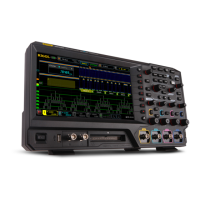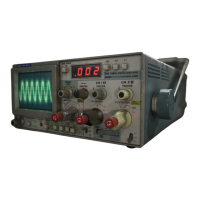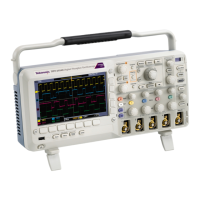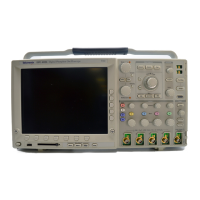Command Groups
Command
Description
EMail:SMTPServer Sets or queries the address of the SMTP
mail server
EMail:STATUS? Queries the status of e-mail
EMail:TIMEOut Sets or queries the global timeout in seconds
EMail:TO Sets or queries the address of the
recipient(
s) of an e-mail. Multiple addresses
are separated with a semicolon (;)
EMail:TRIGger Sets or queries whether e-mail is sent when
a trigger occurs
EMail:WAVEform Sets or queries w hether waveform data is
included
in the e-mail
File System Command Group
Use the commands in the File System Command Group to help you use the
built-in hard disk drive. You can use the commands to do the following:
List the contents of the default directory
Create and delete directories
Crea
te, copy, read, rename, or delete a file
When using these commands, keep the following points in mind:
File arguments are always enclosed within double quotes:
“C:\MYDIR\TEK00001.SET”
File names follow the MSDOS format: [DRIVE:][\PATH\]filename
Path separators may be either forwardslashes(/)orbackslashes(\)
NOTE. Using back slash as a path separator may produce some unexpected
results, depending on how your controller application treats escaped characters.
M
any applications recognize the sequence of back slash followed by an alphabetic
character as an escaped character, and, as such, interpret that alphabetic
character as a control character. For example, the sequence “\n” may be
interpreted a s a newline character; “\t” may be interpreted as a tab character. To
ensure that this interpretation does not occur, you can use double back slashes.
For example, “C:\\testfile.txt”.
Some FILESystem commands may fail because a file has read-only attributes.
You will not be able to delete or replace such files until this attribute is
removed. Refer to the operating system help on file properties for further
information.
DPO7000, DPO70000/B and DSA7000/B Series Programmer Manual 2-21

